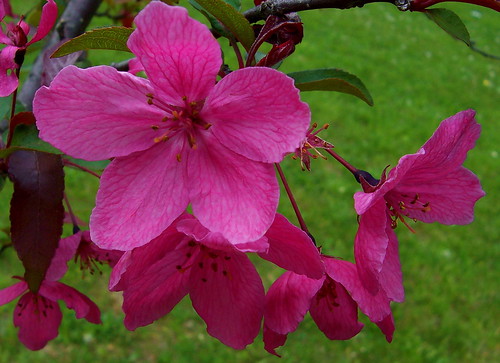Part of this comes from living in the same place my whole life. I can hike past the white flowers blooming under oak trees in late April and know at a glance that they are trilliums. I don't need to kneel down on the ground and look at their leaves to figure that out any more than I need to get out of the car to pick out which of the teenagers milling about the sidewalk of the high school is Shaggy Hair Boy. Most of what grows here is familiar to me, and I learned the names long ago, in childhood perhaps, or on a hike with Poet Woman or Signing Woman, two of my naturalist friends.
I know the names of the flowers in my garden and the trees in my yard because I planted them. The daylilies came from the house where my grandmother lived up until she died. The forsythia bush came from Red-haired Sister's yard, as did the rose of sharon and the chocolate mint. The lily of the valley and the peonies I dug up in my parents' yard. The white pines came from camp, and the lilac bushes from an abandoned house near camp. The hostas came from the garden Reiki Woman had to leave behind when she left her husband.
The plants and trees have not just names, but stories. I often plant a tree or a bush to mark a new stage in my life, sometimes as a way of grieving, sometimes as a way of celebrating, sometimes both at the same time. As I walk around my yard, looking over the gardens, pulling up weeds, deciding what I might add this year, I think about all that has happened in my life since last spring, and what tree or flower would best tell those stories.

The flowers in this photo are Profusion crabapple (Manzano Silvestre). I know that because I planted the tree myself, about seven years ago, and that's what the tag said.

13 comments:
ah, I see you just can't resist the blogging of flower photos! Very nice, as always.
Gorgeous photo, as always.
Chip: After a whole winter of taking photos of snow, it's hard to resist all the colour blossoming outside right now ....
Thanks, Berrybird.
Is there anything in your life that doesn't have a story? I doubt it :). And I'm so glad you share so many with us.
Another piece of eye candy.
I love your photo and I love your stories. Great colors! Mary :-)
I've just started reading your blog in the past few weeks and wish I had the time to go back and read everything. Thanks for being so disciplined and for caring about your words.
You're not much for noticing detail? I may not know you in real life, but this is definitely not a description I would say about you.
Ianqui: Perhaps you are right. Perhaps it is just that so many of my friends and colleagues are trained to be scientists so I never notice detail to the kind of level of precision and accuracy that would satisfy them ....
YES!
You've described exactly my situation now. Most of the old familiar plants have been replaced by new ones, and they tend to blur into a great, green, leafy sameness. And identifying them is very, very hard.
Partly it's because I haven't learned what to look for (unlike when I'm looking at birds, say) and partly there's so much mixing and mingling going on. Is that plant in my yard a weed? An escaped planting? A native plant put there on purpose?
What's particularly galling is when the plant (or animal) is very distinctive and yet I still have no clue about what it is, or how to determine what the important parts are, so that I can track down the possiblities.
"Big leafy weed that has huge leaves and grows in the ground out of a little hole" isn't good enough. Whereas if you show me a creosote bush, my brain doesn't bother with things like leaf shape, waxiness, presence or absence of hairs... it just goes "creosote."
I think I need an on-call ecologist to live next door.
Because I just finished the plant section in Biology, I can tell you that those beautiful pink flowers are dicots and that they are complete and perfect. Now let's see how long I'll retain that knowledge.
Do they smell good?
I love your garden stories! I hope you will consider joining my Sunday Garden Stroll linky with one of these lovely posts. It doesn't have to be a Sunday post BTW. Your flowers are gorgeous!
What color do the leaves turn in the fall?
Post a Comment